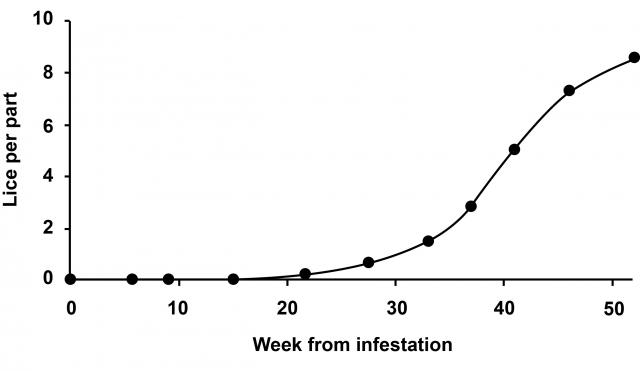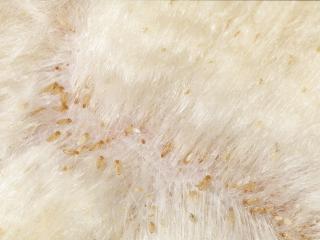Detection
Population build-up
Understanding how quickly lice numbers may increase is important for the following reasons:
- to assess when an economic loss is likely to occur and whether a long wool treatment is justified
- to determine the length of time sheep need to be quarantined to be confident that they are not infested.
This is based on an understanding of the relationship between lice numbers and fleece derangement and the level at which lice are likely to be detected.

Population build-up is a combination of the rate of spread amongst sheep in a mob and the increase in lice numbers on individual sheep. Most new infestations begin from one or just a few sheep that infest the rest of the mob. Lice numbers seen when parting wool on sheep can be used to estimate the total number of lice on the sheep.
| Number of lice seen per 10 centimetre parting | Estimated number on sheep | Level of infestation |
|---|---|---|
| 1 | 2 500 | Light |
| 5 | 12 000 | Moderate |
| 10 | 25 000 | Heavy |
In southern agricultural areas, it is estimated that over a six month period, a low level infestation can develop into a high infestation causing severe rubbing and biting. In pastoral areas, this may take longer due to a slower rate of transmission, the lice being exposed to hot conditions and greater exposure to sunlight, depending on the time of shearing.
Finding lice
Lice can be found on most woolled areas of sheep, although they are rare on the belly. They are not evenly spread with most being found along the sides and on the back, although sometimes, high numbers can be found on the head. The best way to check for lice is to choose any sheep with rubbed wool and part the wool in the rubbed areas on the neck, shoulder, mid-side and flank in bright light. The lice will often cling to wool fibres close to the skin surface and will move away from the light when exposed. A minimum of 10 partings should be done on each side and at least 20 ‘rubbed’ sheep per mob should be checked.
Once one louse has been found, there is no need to inspect more sheep. Lice are very small so when looking for lice, reading glasses should be worn.

Shearing removes 30–50% of lice with the fleece. Additional lice are further killed due to exposure to environmental factors. Shearing also affects distribution, with more being found after shearing on the lower body including under the neck, lower flanks and upper legs and in areas where the wool has not been closely shorn. However, after several months, the distribution is more generalised. Thus is it often difficult to find lice on sheep with less than six months wool.
Lice management
Flock owners are not required to report the presence of lice to the department. They are encouraged to take an active role in treating and managing their flocks for lice to protect the value of fleece product, maintain positive local community relationships and to meet animal welfare obligations. Checking for lice on sale sheep and treating infested animals is the responsibility of flock owners.
This department offers advice to woolgrowers on appropriate chemical choice and management procedures to bring about lice control and eradication with an important component of the overall plan being the implementation of farm biosecurity strategies to keep flocks clean.
